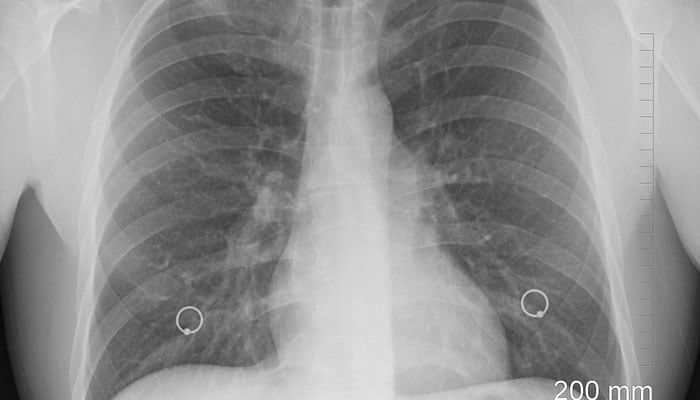Horror as scan reveals tapeworm infestation in lungs of coughing patient
The doctor shows the X-ray to the patient with countless white dots — cysts created by tapeworms
May 09, 2023

Doctors found spiralling tapeworm larvae inside a patient who came to visit the hospital complaining cough, in Brazil. He was shocked to learn that he was hosting numerous tapeworms inside his lungs, reported UK-based Metro.
An X-ray on Twitter was shared by Dr Vitor Borin P. de Souza, a practitioner at the Hospital das Clínicas Botucatu in São Paulo, saying the patient had come in for help with his persistent cough.
But it was learned later that he was suffering from cysticercosis in which tapeworm larvae — that live in humans' intestines — come out elsewhere.
World Health Organisation (WHO) noted that "this condition, also called taeniasis, can be caused by a lot of different tapeworms, but only the Taenia solium, also called the pork tapeworm, causes major health problems."
The larvae form hard lumps called cysts to keep themselves alive for the short term which can be felt through the skin. However, the condition is usually harmless, they can come out of the intestine and go to the brain, and spinal cord and cause epileptic seizures, dementia, and blindness in what one expert called the "most common parasitic disease of the human nervous system."
The cysts can be removed easily through surgery or medicines.
The doctor showed the X-ray to the patient with countless white dots — cysts created by tapeworms.
The doctor said: "Cysticercosis is acquired from ingestion of tapeworm eggs [present in the faeces of humans with tapeworms]. Don’t want to [catch] it? Wash your food well before consuming."
Dr de Souza wrote on Twitter — in the threat which was deleted later — that the patient was awaiting an MRI scan to check for the location of a cyst in his brain.
"If you don't have any injury inside the head, spinal cord, or eyes, you don't even need to treat," Dr de Souza said.
"These lesions are calcified so they are not viable cysticerci [tapeworm larvae]."
WHO said: "About 2,500,000 people are thought to be infected with neurocysticercosis each year."
"Taenia solium is the cause of 30% of epilepsy cases in endemic regions where pigs tend to roam. This can swell to as much as seven in 10 cases for high-risk communities," the WHO added.
"Although 70% of patients with epilepsy could lead a normal life if treated correctly, poverty, ignorance of the disease, inadequate infrastructure in health, or lack of access to medication, cause 75% of people with this condition to be treated poorly if treated at all,” it said.
"If it doesn’t cause any discomfort life goes on," Dr de Souza said.











